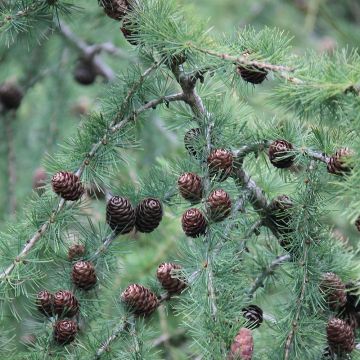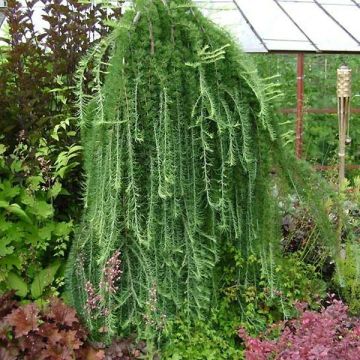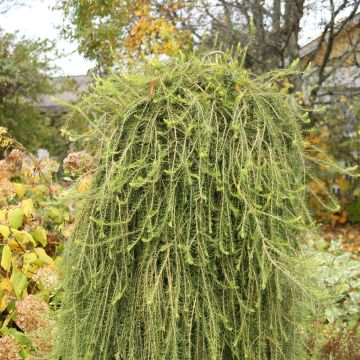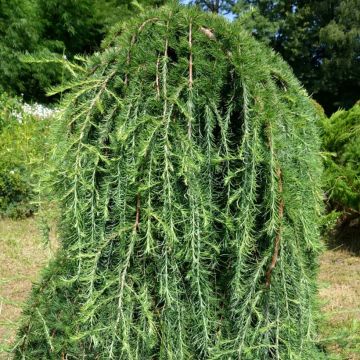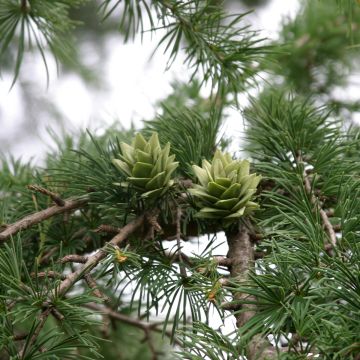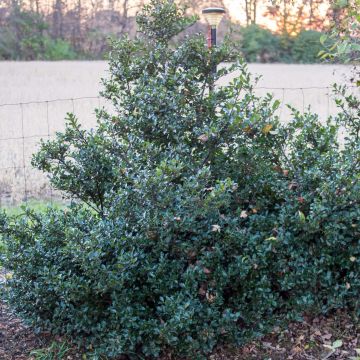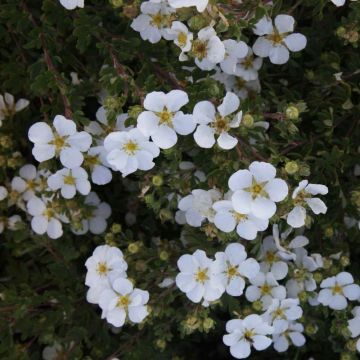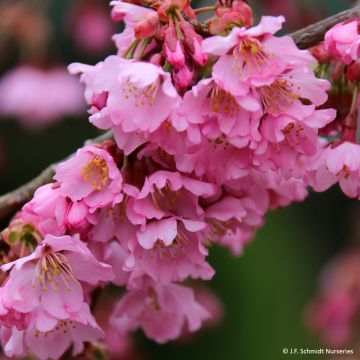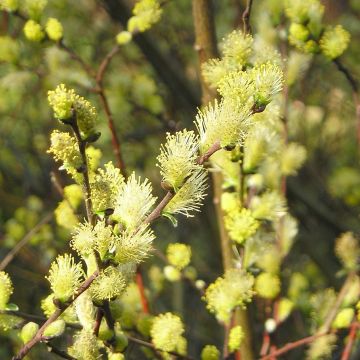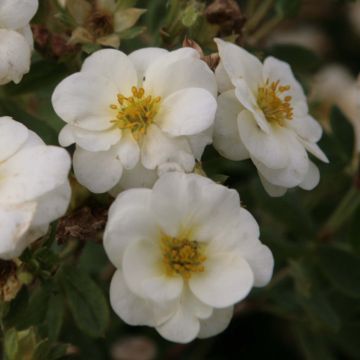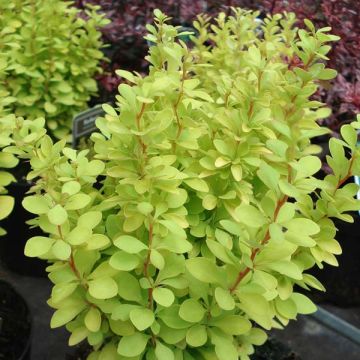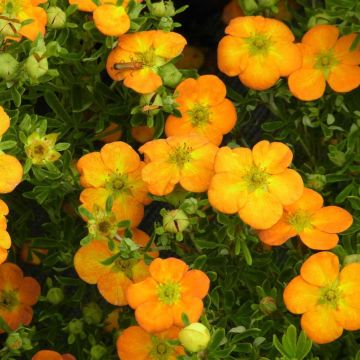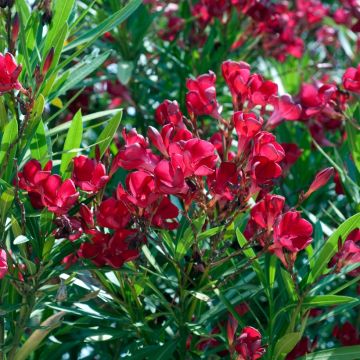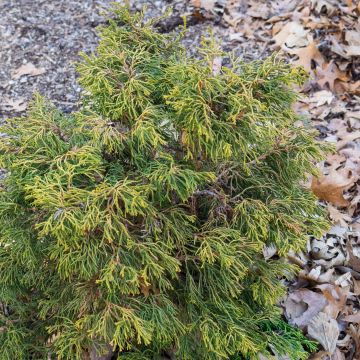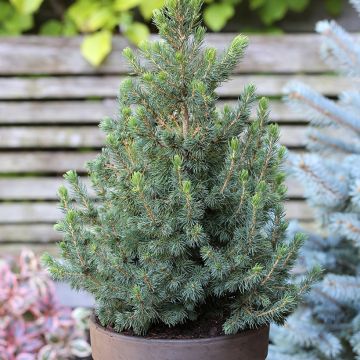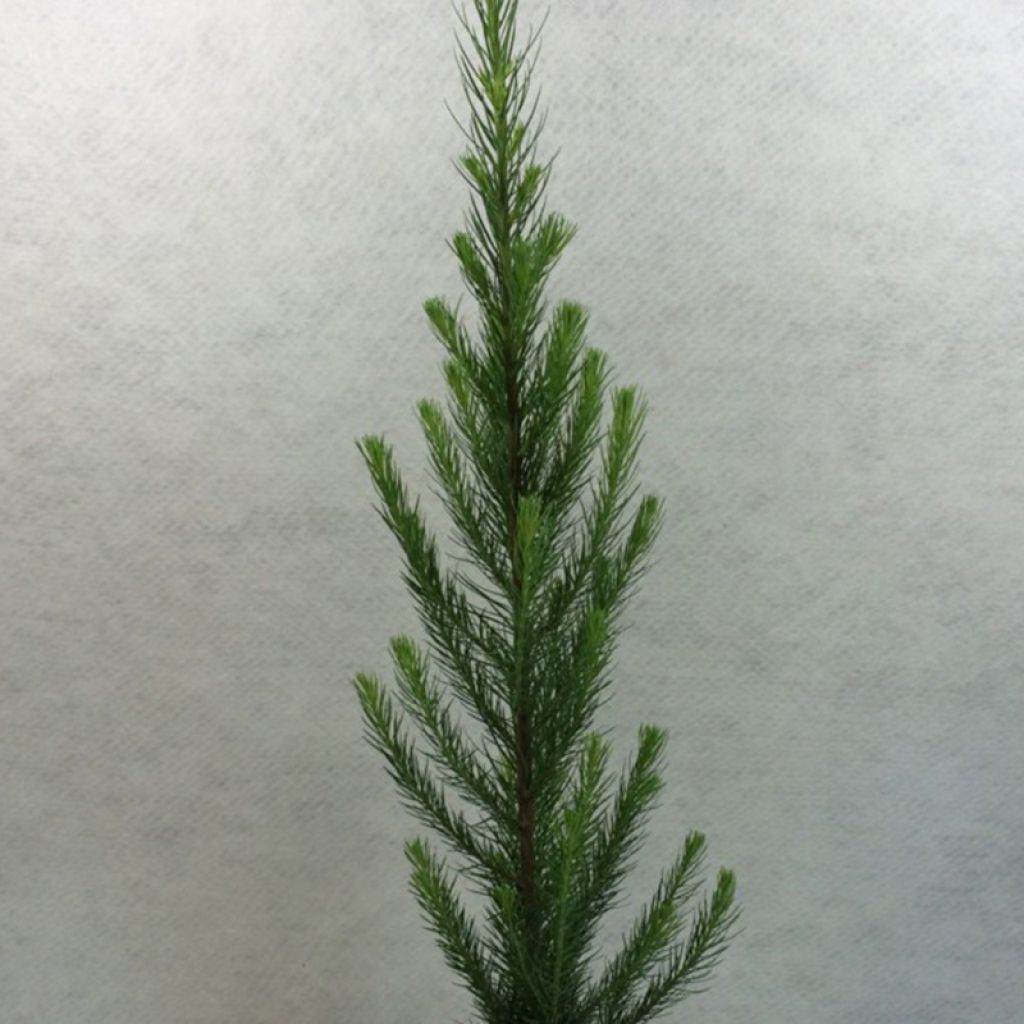

Larix kaempferi Jakobsen's Pyramid - Mélèze du Japon
Larix kaempferi Jakobsens Pyramid - Larch
Larix kaempferi Jakobsen's Pyramid
Japanese Larch, Kaempfer's Larch
No spring revival What a shame I'm truly disappointed
Eric D., 21/05/2018
Why not try an alternative variety in stock?
View all →This plant carries a 24 months recovery warranty
More information
We guarantee the quality of our plants for a full growing cycle, and will replace at our expense any plant that fails to recover under normal climatic and planting conditions.
From €5.90 for pickup delivery and €6.90 for home delivery
Express home delivery from €8.90.
Does this plant fit my garden?
Set up your Plantfit profile →
Description
The Larix kaempferi 'Jacobsen's Pyramid', also known as the dwarf Japanese larch, is a moderately sized deciduous conifer, with an elegant silhouette and a very narrow columnar habit. Its ascending branches are covered with blue-green needles from spring to summer. It takes on a magnificent bronze to orange hue in autumn, before revealing its pink-brown branches in winter. With fairly rapid growth, it will be perfect in a small space, a bed, or as a standalone. Very hardy, it appreciates light, neutral to acidic, fresh soil, and a sunny exposure.
The Japanese larch, the Larix kaempferi also called Larix leptolepis, is a large Japanese conifer with a conical habit that can reach 30 m (98 ft 5 in) in height, with deciduous foliage. It is native to the mountains of Hondo Island, at an altitude ranging between 1,300 and 2,900 m, but it adapts very well to cultivation in lowland areas in a rather cool climate. It belongs to the pine family, like pines, firs and spruces. It is a species very close to the European Larix decidua.
The Larix kaempheri 'Jacobsen's Pyramid' forms, after 10 years, a very slender bush, with a columnar and narrow habit of 3.50 m (11 ft 6 in) in height for 70 cm (27.6 in) in span. Its growth is fairly rapid for a larch. Its long unramified branches emerge from the trunk at a very closed angle, directing up towards the sky. From spring to summer, the foliage is generally blue-green, made up of soft non-prickly needles. These are inserted in dense rosettes on the branches. This larch, like all the others, takes on a magnificent hue in autumn, here bronze with orange reflections. Covering its young stems, its beautiful old pink to pale brown bark is an additional asset in winter.
The 'Jacobsen's Pyramid' larch is a low-maintenance and very elegant conifer, easy to grow in a small garden, in a Japanese or exotic bed, provided the soil remains fairly fresh but drained and that it is placed in a sunny exposure. It can be adopted near an entrance, and its sentinel silhouette suits it well. It easily grows in a large pot to decorate the terrace or balcony. It will go well with bushy or sprawling conifers. The graphic qualities of conifers naturally impose themselves in a contemporary garden, which prefers the aesthetics of shapes, silhouettes and textures to the waltz of flowerings. These plants structurally shape a bed, mark paths, border the terrace, easily substituting the strong presence of pruned boxwood. They associate with the complementary temperaments of shaggy grasses and heathers. The key is to play with volumes and colours.
Advice : Water regularly during the first two years, and in cases of prolonged drought.
Report an error about the product description
Larix kaempferi Jakobsens Pyramid - Larch in pictures
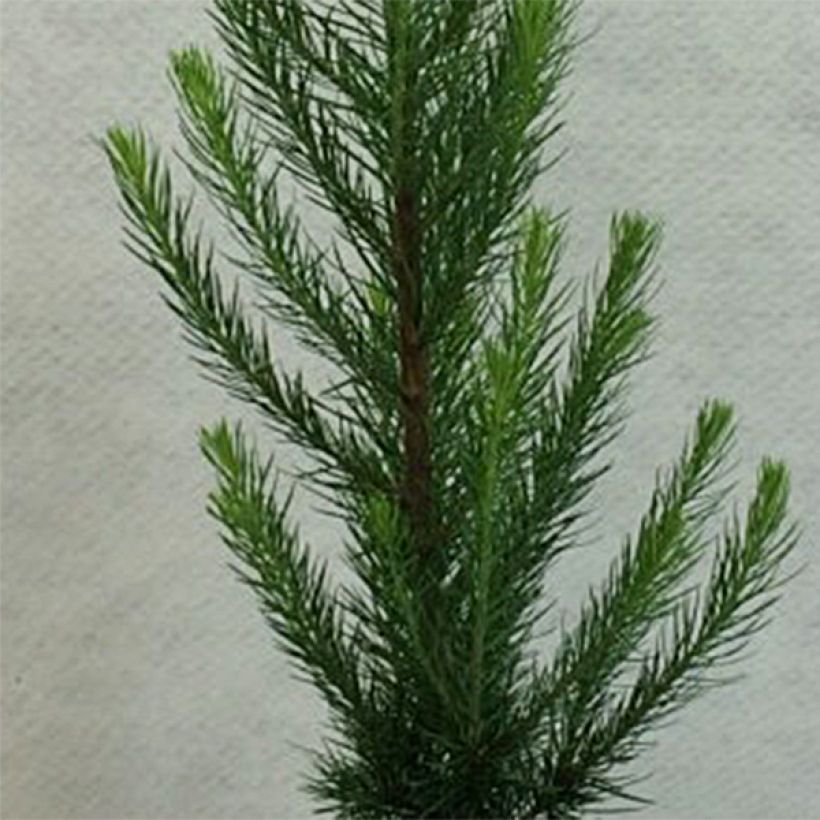

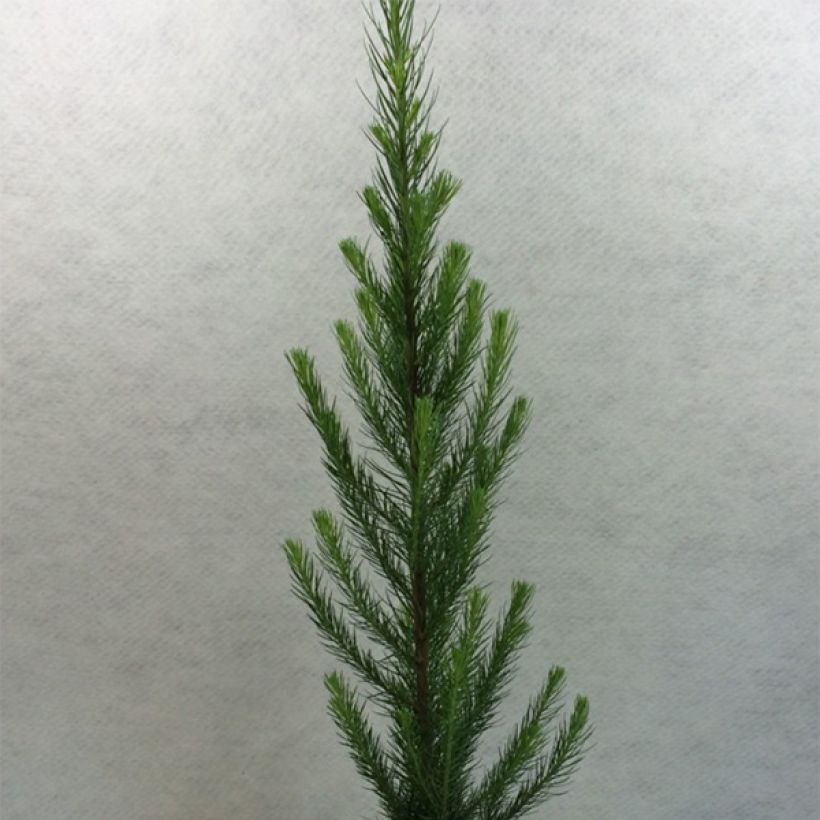

Plant habit
Foliage
Botanical data
Larix
kaempferi
Jakobsen's Pyramid
Pinaceae
Japanese Larch, Kaempfer's Larch
Cultivar or hybrid
Other Larix - Larch
Planting and care
The Larix kaempferi 'Jacobsen's Pyramid' is a plant suited to cool mountain climates, that fears arid situations and late frosts. It is planted from September to November in fresh, well-drained soil, even tolerates poor soil, but without excess lime, in a sunny or semi-shaded location. A mix of coarse sand, heath soil and compost added to the garden soil will suit this plant very well. If soil is too heavy, plant the bush on a mound and mulch it with gravel. Water regularly during the first two years, and in cases of prolonged drought. Soak the root balls well before planting. This very hardy conifer fears heavy, waterlogged soil. Pruning is not necessary, but this conifer can perfectly be pruned to maintain or accentuate its original habit. Pruning will then take place in February-March.
Planting period
Intended location
Care
-
, onOrder confirmed
Reply from on Promesse de fleurs
Shrubs for pots
Haven't found what you were looking for?
Hardiness is the lowest winter temperature a plant can endure without suffering serious damage or even dying. However, hardiness is affected by location (a sheltered area, such as a patio), protection (winter cover) and soil type (hardiness is improved by well-drained soil).

Photo Sharing Terms & Conditions
In order to encourage gardeners to interact and share their experiences, Promesse de fleurs offers various media enabling content to be uploaded onto its Site - in particular via the ‘Photo sharing’ module.
The User agrees to refrain from:
- Posting any content that is illegal, prejudicial, insulting, racist, inciteful to hatred, revisionist, contrary to public decency, that infringes on privacy or on the privacy rights of third parties, in particular the publicity rights of persons and goods, intellectual property rights, or the right to privacy.
- Submitting content on behalf of a third party;
- Impersonate the identity of a third party and/or publish any personal information about a third party;
In general, the User undertakes to refrain from any unethical behaviour.
All Content (in particular text, comments, files, images, photos, videos, creative works, etc.), which may be subject to property or intellectual property rights, image or other private rights, shall remain the property of the User, subject to the limited rights granted by the terms of the licence granted by Promesse de fleurs as stated below. Users are at liberty to publish or not to publish such Content on the Site, notably via the ‘Photo Sharing’ facility, and accept that this Content shall be made public and freely accessible, notably on the Internet.
Users further acknowledge, undertake to have ,and guarantee that they hold all necessary rights and permissions to publish such material on the Site, in particular with regard to the legislation in force pertaining to any privacy, property, intellectual property, image, or contractual rights, or rights of any other nature. By publishing such Content on the Site, Users acknowledge accepting full liability as publishers of the Content within the meaning of the law, and grant Promesse de fleurs, free of charge, an inclusive, worldwide licence for the said Content for the entire duration of its publication, including all reproduction, representation, up/downloading, displaying, performing, transmission, and storage rights.
Users also grant permission for their name to be linked to the Content and accept that this link may not always be made available.
By engaging in posting material, Users consent to their Content becoming automatically accessible on the Internet, in particular on other sites and/or blogs and/or web pages of the Promesse de fleurs site, including in particular social pages and the Promesse de fleurs catalogue.
Users may secure the removal of entrusted content free of charge by issuing a simple request via our contact form.
The flowering period indicated on our website applies to countries and regions located in USDA zone 8 (France, the United Kingdom, Ireland, the Netherlands, etc.)
It will vary according to where you live:
- In zones 9 to 10 (Italy, Spain, Greece, etc.), flowering will occur about 2 to 4 weeks earlier.
- In zones 6 to 7 (Germany, Poland, Slovenia, and lower mountainous regions), flowering will be delayed by 2 to 3 weeks.
- In zone 5 (Central Europe, Scandinavia), blooming will be delayed by 3 to 5 weeks.
In temperate climates, pruning of spring-flowering shrubs (forsythia, spireas, etc.) should be done just after flowering.
Pruning of summer-flowering shrubs (Indian Lilac, Perovskia, etc.) can be done in winter or spring.
In cold regions as well as with frost-sensitive plants, avoid pruning too early when severe frosts may still occur.
The planting period indicated on our website applies to countries and regions located in USDA zone 8 (France, United Kingdom, Ireland, Netherlands).
It will vary according to where you live:
- In Mediterranean zones (Marseille, Madrid, Milan, etc.), autumn and winter are the best planting periods.
- In continental zones (Strasbourg, Munich, Vienna, etc.), delay planting by 2 to 3 weeks in spring and bring it forward by 2 to 4 weeks in autumn.
- In mountainous regions (the Alps, Pyrenees, Carpathians, etc.), it is best to plant in late spring (May-June) or late summer (August-September).
The harvesting period indicated on our website applies to countries and regions in USDA zone 8 (France, England, Ireland, the Netherlands).
In colder areas (Scandinavia, Poland, Austria...) fruit and vegetable harvests are likely to be delayed by 3-4 weeks.
In warmer areas (Italy, Spain, Greece, etc.), harvesting will probably take place earlier, depending on weather conditions.
The sowing periods indicated on our website apply to countries and regions within USDA Zone 8 (France, UK, Ireland, Netherlands).
In colder areas (Scandinavia, Poland, Austria...), delay any outdoor sowing by 3-4 weeks, or sow under glass.
In warmer climes (Italy, Spain, Greece, etc.), bring outdoor sowing forward by a few weeks.

































